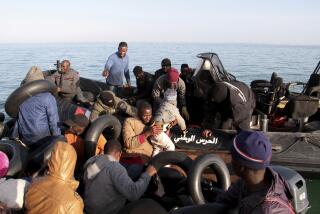Briefing Paper : North Africa Moves Toward Joint Market : The News:
- Share via
CAIRO — Leaders of the 17-month-old Arab Maghreb Union will meet Saturday in Algiers to advance plans for a North African common market that would parallel the more unified European Community upcoming by the end of 1992.
Substantial progress is considered possible on an agreement to eliminate trade barriers and customs duties, allowing free circulation of goods among the five Maghreb countries--Algeria, Libya, Mauritania, Morocco and Tunisia. Also up for discussion, but still probably not ready for adoption, are similar proposals to eliminate travel restrictions for Maghreb citizens.
Politically, last month’s unexpected municipal elections victory by Muslim fundamentalists in Algeria will be high on the agenda. And the five are to decide whether to establish a permanent seat for the Arab Maghreb Union. Until now, the organization’s headquarters has rotated along with the AMU chairmanship every six months.
The Background:
Faced with severe economic troubles at home and potentially crippling cutbacks in their access to European markets, the five AMU countries agreed Feb. 17, 1989, to set aside decades of political squabbling and competition in favor of greater economic cooperation. The hope: that unity would give them a stronger voice in dealing with Europe and that greater mutual trade among the member countries could make up for any European trade lost after 1992, the target date for Western Europe to institute a true common market.
“Our aim,” King Hassan II of Morocco said, “is to turn the Arab Maghreb into one country, with one passport, one identity and a single currency.”
At first glance, the five countries could hardly be less suited to development of a common market. Trade among them has averaged only about 3% of the region’s total trade, while trade with Europe is over 60%.
Moreover, the economies of the member countries often overlap. The olive oil that directly or indirectly supports 30% of Tunisia’s farmers is also a big moneymaker for Morocco. The same is true, to a lesser extent, for those countries’ citrus and phosphate exports. Algeria and Libya both rely heavily on their oil exports and petrochemical industries. Mauritania produces a lot of fish, but so does everyone else.
Although building intra-Maghreb trade is clearly not going to be easy, the five nations feel they have much to fear from European union.
The Threat:
Agricultural-based economies like Morocco’s and Tunisia’s perhaps have the most to lose from Europe’s rush toward 1992. Until now, their agricultural exports have flowed across the Mediterranean duty-free, but the inclusion of Greece, Portugal and Spain in the European Community--countries that also have plenty of citrus, olives and wine to export--has produced a lot of teeth-grinding on the southern Mediterranean rim.
The Maghreb Studies Assn. in London estimates that Morocco’s agricultural exports to Europe will be cut in half after 1992. Its wine production, the association declared, “will be almost all closed down.”
Moreover, all the Maghreb countries have reason to worry about what effect the free flow of people across European borders will have on the 3 million workers now in Europe who are currently sending their paychecks home.
Countries such as France, West Germany and Belgium are already making noises about tightening entry restrictions on North Africans, and an open border policy will likely mean other European countries will be encouraged to impose similar clampdowns.
“The bottom line is they see this big monolith growing up on the other side of the Mediterranean, and they want to see if there’s something they can do about it,” said one analyst.
Europe’s View:
The European Community has been anxious to reassure the North Africans. “The fact that we are going to have one market and not 12 markets will definitely make things easier for them,” said one European Community analyst posted in Algiers. “There is no doubt that the creation of this ’92 market is going to be for them more of an opportunity than a problem.”
The European group recently negotiated an agreement allowing the Maghreb countries to maintain existing trade levels in products such as citrus even after 1992. A separate agreement on textiles allows countries such as Morocco and Tunisia to accelerate exports up to a certain level and leaves the door open for continued negotiations. But privately, many European leaders fear that if North Africa’s economy does get worse, it will only mean more illegal immigration from the Maghreb. Accordingly, the European Community has proposed a 40% increase from the current $160 million in annual aid that it sends to North Africa--an idea that is still far from winning consensus.
Progress So Far:
Since the union’s initial meeting in 1989, AMU committees have been formed to study almost every conceivable facet of cooperation, and some headway has been made.
In the discussion stage is construction of a Maghreb Highway from Libya to the Atlantic, establishment of a common airline (Air Maghreb) and funding of a common investment bank. Tentative accords have been signed exempting cross-border investors from double taxation.
Algeria already has an operating pipeline transporting natural gas through Tunisia and on to Italy, and a second pipeline is in the works that would access Europe, across Gibraltar, through Morocco.
Political Complications:
With the region’s long history of cross-border squabbling, the Arab Maghreb Union faces political hurdles as well.
A January summit was hampered by a new flare-up in the Western Sahara dispute that has kept Morocco and Algeria at odds for years. (Algeria supports the Polisario rebels who dispute Morocco’s claim to the former Spanish colony.) Mauritania accuses Morocco of favoring rival Senegal in a bloody conflict between those countries. And Tunisia and Libya have a history of military conflict.
Indeed, Libya and its mercurial strongman, Col. Moammar Kadafi, have been a big question mark from the beginning.
Kadafi, a vocal champion of Arab unity, insisted at first on an immediate and total merger joining all five Maghreb countries and four other African states. To accommodate him, the inaugural AMU text described the union as “only one essential stage on the way to the creation of Arab unity.”
But privately, leaders of the Maghreb countries believe that they have had a moderating influence on Kadafi. In any case, said one analyst, they feel more comfortable “having him inside the tent than outside the tent.”
Outlook:
For all the barriers, Maghreb officials predict they will eventually make progress toward greater unity, if only because they have to. “Any country in the world cannot afford to live alone now,” said Algerian diplomat Belkacem Madani. “The world has become very small, and that means the necessity of links between nations.”
Maghreb Union: a Regional Snapshot
MOROCCO Leader: King Hassan II Population: 24.2 million (1989 est.) Area: 269,756 square miles Capital: Rabat
TUNISIA Leader: President Zine Abidine ben Ali Population: 8.1 million (1989 est.) Area: 63,170 square miles Capital: Tunis
LIBYA Leader: Col. Moammar Kadafi Population: 4.4 million (1989 est.) Area: 679,358 square miles Capital: Tripoli
MAURITANIA Leader: Col. Sid Ahmed Ouid Taya Population: 2.1 million (1989 est.) Area: 397,953 square miles Capital: Nouakchott
ALGERIA Leader: President Chadii Bendjedid Population: 23.6 million (1989 est.) Area: 919,590 square miles Capital: Algiers
EXPORTS FROM MAGHREB COUNTRIES TO EUROPEAN COMMUNITY
Fiscal 1989 (October 1988 thru October 1989)
In millions of U.S. dollars Tunisia: $2,399 Morocco: 3,951 Mauritania: 896 Libya: 7,912 Algeria: 6,995
TRADE BALANCE
Maghreb-European Community
In million of U.S. dollars SOURCE: European Community
More to Read
Sign up for Essential California
The most important California stories and recommendations in your inbox every morning.
You may occasionally receive promotional content from the Los Angeles Times.













